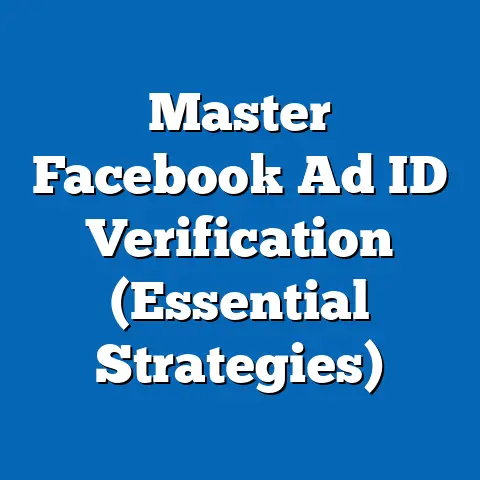Unlock Facebook Ad Receipts for Winning Campaigns (Expert Tips)
If you’re not analyzing your Facebook ad receipts, you’re leaving money on the table. I’ve seen it happen countless times. Businesses pour money into Facebook ads, hoping for a magic bullet, only to be disappointed. But the truth is, the magic isn’t in the platform itself; it’s in understanding the data it provides. And that starts with mastering your Facebook ad receipts.
Think of your Facebook ad receipts as a detailed treasure map. They hold the clues to unlocking a winning campaign, revealing what’s working, what’s not, and where you need to adjust your sails. Ignoring them is like navigating without a compass – you’re bound to get lost.
Section 1: Understanding Facebook Ad Receipts
So, what exactly are Facebook ad receipts? They’re more than just a bill from Meta; they’re a comprehensive record of your ad spend and performance on the platform. Think of them as a detailed report card for each of your campaigns, ad sets, and individual ads.
Defining Facebook Ad Receipts
A Facebook ad receipt isn’t a single document. It’s a collection of data points and reports available within the Facebook Ads Manager that provides a breakdown of your advertising costs and the results those costs generated. This includes:
- Spend: The total amount of money you’ve spent on a particular ad, ad set, or campaign.
- Impressions: The number of times your ad was displayed to users.
- Reach: The number of unique users who saw your ad.
- Clicks: The number of times users clicked on your ad.
- Cost-Per-Click (CPC): The average cost you paid for each click on your ad.
- Conversions: The number of desired actions users took after seeing or clicking your ad (e.g., purchase, sign-up, lead generation).
- Cost-Per-Conversion (CPA): The average cost you paid for each conversion.
- Click-Through Rate (CTR): The percentage of users who saw your ad and clicked on it.
- Relevance Score (Now Ad Relevance Diagnostics): A measure of how relevant your ad is to your target audience (this has evolved into a more comprehensive system of Ad Relevance Diagnostics which includes quality ranking, engagement rate ranking, and conversion rate ranking).
These are just some of the key metrics included in your Facebook ad receipts. The specific metrics available will depend on your campaign objectives and the type of ads you’re running.
The Role of Ad Receipts in Advertising
Facebook ad receipts play a vital role in advertising by providing a clear picture of how your ad dollars are being spent and what results they’re generating. They allow you to:
- Track Performance: Monitor the performance of your campaigns in real-time.
- Identify Trends: Spot trends and patterns in your data to understand what’s working and what’s not.
- Optimize Campaigns: Make data-driven adjustments to your campaigns to improve performance and ROI.
- Justify Spend: Demonstrate the value of your advertising efforts to stakeholders.
- Improve Targeting: Refine your targeting to reach the most receptive audience.
- Test Different Creatives: Evaluate the effectiveness of different ad creatives and messaging.
Without this data, you’re essentially flying blind. You’re relying on guesswork and intuition, which, in my experience, rarely leads to sustainable success.
Significance in Tracking ROI and Campaign Success
The ultimate goal of any advertising campaign is to generate a positive return on investment (ROI). Facebook ad receipts are essential for tracking ROI and measuring campaign success. By analyzing the data in your receipts, you can determine:
- Whether your campaigns are profitable.
- Which campaigns are the most profitable.
- Which ad sets and ads are driving the most conversions.
- Whether your targeting is effective.
- Whether your ad creatives are resonating with your audience.
This information allows you to make informed decisions about where to allocate your budget and how to optimize your campaigns for maximum ROI.
Takeaway: Facebook ad receipts are more than just a bill; they’re a treasure trove of data that can help you unlock the full potential of your Facebook advertising efforts. Understanding what they are and the role they play is the first step towards creating winning campaigns. Next, we’ll dive into why data-driven decisions are so crucial.
Section 2: The Importance of Data-Driven Decisions
In today’s digital landscape, gut feelings and intuition alone simply don’t cut it. Successful marketing relies on data-driven decision-making. I remember a time when I relied heavily on my “instincts” when managing a campaign for a local restaurant. I thought I knew their target audience inside and out. Turns out, I was completely wrong! It wasn’t until I started meticulously analyzing the ad data that I realized I was targeting the wrong demographics and interests. That experience taught me a valuable lesson: data trumps intuition every time.
Emphasizing Data-Driven Decision-Making
Data-driven decision-making involves using data to inform your marketing strategies and tactics. This means:
- Collecting data from various sources, including Facebook ad receipts.
- Analyzing the data to identify trends and patterns.
- Using the insights gained from the data to make informed decisions about your campaigns.
- Continuously monitoring and evaluating your results to refine your strategies.
This approach allows you to move beyond guesswork and make decisions based on concrete evidence. It’s about understanding what’s actually working and what’s not, rather than relying on assumptions.
Statistics and Case Studies
The power of data-driven decision-making is undeniable. Here are a few statistics and case studies to illustrate its impact:
- McKinsey: Companies that put data at the center of their marketing and sales decisions see a 15-20% improvement in marketing ROI.
- HubSpot: Businesses that use data-driven marketing are six times more likely to be profitable year-over-year.
- Case Study: Airbnb: Airbnb uses data to personalize user experiences, optimize pricing, and target marketing efforts, resulting in a significant increase in bookings and revenue.
- Case Study: Netflix: Netflix relies heavily on data to understand user preferences and recommend content, leading to higher engagement and subscriber retention.
These examples demonstrate that data-driven decision-making is not just a buzzword; it’s a proven strategy for achieving marketing success.
How Data Analysis Leads to Better Targeting, Budget Allocation, and Ad Creative Adjustments
Analyzing your Facebook ad receipts can lead to significant improvements in your campaigns by:
- Better Targeting: Identifying which demographics, interests, and behaviors are most responsive to your ads, allowing you to refine your targeting and reach a more qualified audience. For example, I once noticed that a campaign targeting “entrepreneurs” was performing poorly. After analyzing the data, I realized that the ads were resonating much better with a more specific segment: “small business owners in the tech industry.” By narrowing my focus, I was able to significantly improve the campaign’s performance.
- Optimized Budget Allocation: Determining which campaigns, ad sets, and ads are generating the best ROI, allowing you to allocate your budget more effectively and maximize your returns. Don’t be afraid to kill off underperforming campaigns and shift your budget to those that are delivering results.
- Improved Ad Creative Adjustments: Evaluating the effectiveness of different ad creatives and messaging, allowing you to create ads that resonate with your target audience and drive conversions. A/B testing is your best friend here! Try different headlines, images, and calls to action to see what works best.
By leveraging the data in your Facebook ad receipts, you can make informed decisions that lead to significant improvements in your campaign performance and ROI.
Takeaway: Data-driven decision-making is the cornerstone of successful Facebook advertising. By analyzing your ad receipts, you can gain valuable insights that will help you improve your targeting, budget allocation, and ad creative adjustments. Next, I’ll walk you through how to access and interpret your Facebook ad receipts.
Section 3: How to Access and Interpret Facebook Ad Receipts
Now that you understand the importance of Facebook ad receipts, let’s dive into how to access and interpret them. Don’t worry, it’s not as complicated as it might seem!
Step-by-Step Guide to Accessing Ad Receipts
Here’s a step-by-step guide on how to access your ad receipts in Facebook Ads Manager:
- Log in to Facebook Ads Manager: Go to https://www.facebook.com/adsmanager and log in to your Facebook account.
- Select Your Ad Account: If you have multiple ad accounts, select the one you want to access.
- Navigate to “Reports”: In the left-hand navigation menu, click on “Reports”. This might also be labelled as “Ads Reporting”.
- Create a Custom Report: Click on the “Create Custom Report” button.
- Choose Your Metrics: Select the metrics you want to include in your report. I recommend starting with the key metrics I mentioned earlier: Spend, Impressions, Reach, Clicks, CPC, Conversions, CPA, and CTR.
- Set Your Date Range: Choose the date range you want to analyze. You can select a pre-defined date range (e.g., Today, Yesterday, Last 7 Days) or set a custom date range.
- Break Down Your Data (Optional): You can break down your data by various dimensions, such as Campaign, Ad Set, Ad, Age, Gender, and Placement. This allows you to analyze your performance at a more granular level.
- Run Your Report: Click on the “Run Report” button.
- Export Your Report (Optional): You can export your report to a CSV file for further analysis in a spreadsheet program like Excel or Google Sheets.
Key Metrics to Focus On
While all the metrics in your Facebook ad receipts are important, some are more critical than others. Here are the key metrics you should focus on:
- Cost-Per-Click (CPC): This metric tells you how much you’re paying for each click on your ad. A high CPC can indicate that your targeting is too broad, your ad creative is not compelling, or your quality score is low. I generally aim for a CPC below \$1, but this can vary depending on your industry and target audience.
- Click-Through Rate (CTR): This metric measures the percentage of users who saw your ad and clicked on it. A high CTR indicates that your ad is relevant and engaging to your target audience. I aim for a CTR above 1%, but again, this can vary.
- Conversion Rate: This metric measures the percentage of users who took a desired action (e.g., purchase, sign-up, lead generation) after clicking on your ad. A low conversion rate can indicate issues with your landing page, your offer, or your targeting.
- Cost-Per-Conversion (CPA): This metric tells you how much you’re paying for each conversion. A high CPA can indicate issues with your targeting, your ad creative, your landing page, or your offer. Your target CPA will depend on your profit margins and the value of each conversion.
- Relevance Diagnostics (Quality Ranking, Engagement Rate Ranking, Conversion Rate Ranking): These diagnostics help you understand how relevant your ad is to your target audience. Low rankings can indicate issues with your targeting, your ad creative, or your landing page. Facebook provides feedback on which areas need improvement.
Interpreting Metrics to Gauge Campaign Performance
Once you have your data, it’s time to interpret it and gauge your campaign performance. Here are some tips:
- Compare Your Metrics Over Time: Track your metrics over time to identify trends and patterns. Are your CPCs increasing or decreasing? Is your CTR improving or declining? This will help you understand how your campaigns are performing and whether your optimizations are working.
- Benchmark Your Metrics Against Industry Averages: Research industry averages for your key metrics to see how you stack up against your competitors. Keep in mind that industry averages can vary widely, so it’s important to find benchmarks that are relevant to your specific business and target audience.
- Segment Your Data: Break down your data by Campaign, Ad Set, Ad, Age, Gender, and Placement to identify which segments are performing best. This will help you refine your targeting and optimize your campaigns for maximum ROI.
- Look for Correlations: Look for correlations between different metrics. For example, is there a correlation between your CTR and your Conversion Rate? If so, this could indicate that improving your CTR will also improve your Conversion Rate.
- Don’t Get Overwhelmed: It’s easy to get overwhelmed by the amount of data available in your Facebook ad receipts. Focus on the key metrics I mentioned earlier and don’t try to analyze everything at once. Start with the big picture and then drill down into the details as needed.
Takeaway: Accessing and interpreting your Facebook ad receipts is essential for understanding your campaign performance and making data-driven decisions. Focus on the key metrics, compare your metrics over time, benchmark against industry averages, segment your data, and look for correlations. Next, I’ll discuss some common pitfalls to avoid in your Facebook ad campaigns.
Section 4: Common Pitfalls in Facebook Ad Campaigns
Even with a solid understanding of Facebook ad receipts, it’s easy to fall into common traps that can derail your campaigns. I’ve seen these mistakes made time and time again, even by experienced marketers.
Identifying Common Mistakes
Here are some common mistakes advertisers make that can lead to poor performance:
- Poor Targeting: Targeting too broad an audience, or targeting the wrong audience altogether. This leads to wasted ad spend and low conversion rates.
- Uncompelling Ad Creative: Using boring or irrelevant ad creative that doesn’t resonate with your target audience. This results in low CTRs and high CPCs.
- Poor Landing Page Experience: Sending users to a landing page that is slow, irrelevant, or difficult to navigate. This leads to low conversion rates.
- Lack of Testing: Not testing different ad creatives, targeting options, and landing pages. This prevents you from identifying what works best and optimizing your campaigns for maximum ROI.
- Ignoring Data: Not analyzing your Facebook ad receipts and making data-driven adjustments to your campaigns. This leads to wasted ad spend and missed opportunities.
- Setting Unrealistic Expectations: Expecting overnight success and giving up too soon. Facebook advertising takes time and effort to optimize.
- Not Having a Clear Goal: Running ads without a clear objective in mind. Are you trying to generate leads, drive sales, or build brand awareness? Your goals will influence your strategy.
How Lack of Analysis Exacerbates Mistakes
A lack of analysis of your Facebook ad receipts can exacerbate these mistakes by:
- Hiding the Problem: Preventing you from identifying the root cause of your poor performance.
- Wasting Ad Spend: Allowing you to continue spending money on ineffective campaigns.
- Missing Opportunities: Preventing you from identifying and capitalizing on opportunities to improve your performance.
- Leading to Frustration: Causing you to become frustrated and give up on Facebook advertising altogether.
Without analyzing your data, you’re essentially operating in the dark. You’re making decisions based on guesswork and intuition, which can lead to costly mistakes.
Expert Insights to Avoid Pitfalls
Here are some expert insights to help you avoid these common pitfalls:
- Define Your Target Audience: Before you start running ads, take the time to define your target audience in detail. Consider their demographics, interests, behaviors, and pain points. The more specific you are, the better.
- Create Compelling Ad Creative: Invest in creating high-quality ad creative that is relevant and engaging to your target audience. Use eye-catching images and videos, write compelling headlines and ad copy, and include a clear call to action.
- Optimize Your Landing Page: Ensure that your landing page is fast, relevant, and easy to navigate. Use a clear headline, compelling copy, and a strong call to action.
- Test, Test, Test: Continuously test different ad creatives, targeting options, and landing pages to identify what works best. Use A/B testing to compare different variations and track your results.
- Analyze Your Data Regularly: Make it a habit to analyze your Facebook ad receipts regularly. Look for trends and patterns, identify areas for improvement, and make data-driven adjustments to your campaigns.
- Be Patient: Don’t expect overnight success. Facebook advertising takes time and effort to optimize. Be patient, persistent, and willing to experiment.
- Set Realistic Expectations: Understand that Facebook advertising is not a magic bullet. It’s a powerful tool, but it requires careful planning, execution, and optimization to achieve success.
- Define Your Goals: Before launching any campaign, clearly define your goals. What are you trying to achieve? This will help you measure your success and make informed decisions about your strategy.
Takeaway: Avoiding common pitfalls in Facebook ad campaigns requires a combination of careful planning, compelling ad creative, a positive landing page experience, and, most importantly, consistent data analysis. By understanding these pitfalls and following the expert insights I’ve shared, you can significantly improve your chances of success. Next, I’ll share some specific tips for maximizing your Facebook ad receipts.
Section 5: Expert Tips for Maximizing Facebook Ad Receipts
Now, let’s get into the nitty-gritty of maximizing your Facebook ad receipts. These are the strategies and tactics I use every day to help my clients achieve their advertising goals.
Setting Clear Objectives and KPIs
The first step to maximizing your Facebook ad receipts is to set clear objectives and key performance indicators (KPIs). This means defining what you want to achieve with your advertising campaigns and how you will measure your success.
- Objectives: What are you trying to achieve with your advertising campaigns? Are you trying to generate leads, drive sales, build brand awareness, or something else?
-
KPIs: How will you measure your success? What metrics will you track to determine whether you’re achieving your objectives? Examples of KPIs include:
- Cost Per Lead (CPL)
- Cost Per Acquisition (CPA)
- Return on Ad Spend (ROAS)
- Conversion Rate
- Click-Through Rate (CTR)
KPIs: How will you measure your success? What metrics will you track to determine whether you’re achieving your objectives? Examples of KPIs include:
- Cost Per Lead (CPL)
- Cost Per Acquisition (CPA)
- Return on Ad Spend (ROAS)
- Conversion Rate
- Click-Through Rate (CTR)
Once you have defined your objectives and KPIs, you can use your Facebook ad receipts to track your progress and make data-driven adjustments to your campaigns.
Regularly Reviewing Ad Performance and Making Data-Driven Adjustments
Regularly reviewing your ad performance is crucial for maximizing your Facebook ad receipts. This means setting aside time each week (or even each day) to analyze your data and identify areas for improvement.
- Look for Trends: Are your CPCs increasing or decreasing? Is your CTR improving or declining?
- Identify Outliers: Are there any campaigns, ad sets, or ads that are performing significantly better or worse than others?
- Compare Performance Across Segments: How are different demographics, interests, and behaviors performing?
Based on your analysis, make data-driven adjustments to your campaigns. This could include:
- Refining Your Targeting
- Updating Your Ad Creative
- Adjusting Your Bids
- Pausing Underperforming Campaigns
Using A/B Testing
A/B testing is a powerful technique for maximizing your Facebook ad receipts. It involves creating two or more versions of an ad, ad set, or landing page and testing them against each other to see which performs best.
- Ad Creative: Test different headlines, images, videos, and ad copy.
- Targeting: Test different demographics, interests, and behaviors.
- Landing Pages: Test different headlines, copy, and calls to action.
- Bidding Strategies: Test different bidding strategies.
By A/B testing, you can identify the most effective elements of your campaigns and optimize them for maximum ROI.
Segmenting Audiences Based on Receipt Data
Segmenting your audiences based on receipt data is another powerful technique for maximizing your Facebook ad receipts. This involves creating different audiences based on their behavior and performance.
- Website Visitors: Create an audience of people who have visited your website.
- Engaged Users: Create an audience of people who have engaged with your Facebook page or ads.
- Past Purchasers: Create an audience of people who have purchased from you in the past.
- Lookalike Audiences: Create lookalike audiences based on your existing customers or website visitors.
By segmenting your audiences, you can tailor your messaging and offers to each group, resulting in higher conversion rates and lower costs.
Takeaway: Maximizing your Facebook ad receipts requires a proactive and data-driven approach. Set clear objectives and KPIs, regularly review your ad performance, use A/B testing, and segment your audiences based on receipt data. These strategies will help you optimize your campaigns for maximum ROI. Next, I’ll share some case studies of businesses that have successfully used Facebook ad receipts to improve their campaigns.
Section 6: Case Studies of Successful Campaigns
To illustrate the power of Facebook ad receipts, let’s take a look at some case studies of businesses that have successfully used them to improve their campaigns.
Case Study 1: E-Commerce Store
- Business: An e-commerce store selling handmade jewelry.
- Challenge: Low conversion rates and high CPA.
-
Solution:
- Analyzed their Facebook ad receipts and discovered that their ads were performing poorly on mobile devices.
- Optimized their website for mobile devices and created mobile-specific ad creative.
- Segmented their audience by age and discovered that their ads were resonating best with women aged 25-44.
- Refined their targeting to focus on this demographic.
-
Results:
-
Increased conversion rates by 50%.
- Reduced CPA by 30%.
Solution:
- Analyzed their Facebook ad receipts and discovered that their ads were performing poorly on mobile devices.
- Optimized their website for mobile devices and created mobile-specific ad creative.
- Segmented their audience by age and discovered that their ads were resonating best with women aged 25-44.
- Refined their targeting to focus on this demographic.
-
Results:
-
Increased conversion rates by 50%.
- Reduced CPA by 30%.
Results:
Increased conversion rates by 50%.
Case Study 2: Local Restaurant
- Business: A local restaurant trying to drive more traffic to their establishment.
- Challenge: Low brand awareness and difficulty reaching their target audience.
-
Solution:
- Analyzed their Facebook ad receipts and discovered that their ads were performing well with people who were interested in “food” and “restaurants.”
- Created a lookalike audience based on their existing customers.
- Ran ads promoting their daily specials and happy hour deals.
-
Results:
-
Increased foot traffic by 20%.
- Increased brand awareness in their local community.
Solution:
- Analyzed their Facebook ad receipts and discovered that their ads were performing well with people who were interested in “food” and “restaurants.”
- Created a lookalike audience based on their existing customers.
- Ran ads promoting their daily specials and happy hour deals.
-
Results:
-
Increased foot traffic by 20%.
- Increased brand awareness in their local community.
Results:
Increased foot traffic by 20%.
Case Study 3: SaaS Company
- Business: A SaaS company selling project management software.
- Challenge: High CPL and difficulty generating qualified leads.
-
Solution:
- Analyzed their Facebook ad receipts and discovered that their ads were performing poorly with people who were not in management roles.
- Refined their targeting to focus on people in management roles.
- Created a lead magnet (a free e-book) to attract more qualified leads.
- Ran ads promoting their lead magnet.
-
Results:
-
Reduced CPL by 40%.
- Increased the number of qualified leads generated.
Solution:
- Analyzed their Facebook ad receipts and discovered that their ads were performing poorly with people who were not in management roles.
- Refined their targeting to focus on people in management roles.
- Created a lead magnet (a free e-book) to attract more qualified leads.
- Ran ads promoting their lead magnet.
-
Results:
-
Reduced CPL by 40%.
- Increased the number of qualified leads generated.
Results:
Reduced CPL by 40%.
Testimonials
“Analyzing our Facebook ad receipts has been a game-changer for our business. We’ve been able to identify what’s working and what’s not and make data-driven adjustments to our campaigns that have significantly improved our ROI.” – Marketing Manager, E-Commerce Store
“I used to feel like I was throwing money away on Facebook ads. But now that I understand how to analyze my ad receipts, I feel much more confident and in control of my advertising spend.” – Small Business Owner, Local Restaurant
Takeaway: These case studies demonstrate the power of Facebook ad receipts in improving campaign performance and achieving business goals. By analyzing their data, these businesses were able to identify areas for improvement, refine their targeting, and optimize their ad creative. Next, I’ll discuss some advanced strategies for seasoned advertisers.
Section 7: Advanced Strategies for Seasoned Advertisers
For those of you who are already experienced with Facebook advertising, here are some advanced strategies for leveraging Facebook ad receipts to take your campaigns to the next level.
Retargeting Strategies Based on Past Ad Performance
Retargeting is a powerful technique for re-engaging users who have previously interacted with your website or ads. By analyzing your Facebook ad receipts, you can create highly targeted retargeting campaigns based on past ad performance.
- Retarget Users Who Clicked on Your Ads: Create an audience of users who clicked on your ads but didn’t convert. Target them with a special offer or a reminder of the benefits of your product or service.
- Retarget Users Who Visited Specific Pages on Your Website: Create an audience of users who visited specific pages on your website (e.g., product pages, pricing pages). Target them with ads that are relevant to the pages they visited.
- Retarget Users Who Abandoned Their Shopping Cart: Create an audience of users who added items to their shopping cart but didn’t complete the purchase. Target them with a reminder of their abandoned cart and a special offer to encourage them to complete the purchase.
Utilizing the Facebook Pixel
The Facebook Pixel is a powerful tool for tracking user behavior on your website and measuring the effectiveness of your Facebook ads. By installing the Facebook Pixel on your website, you can track:
- Page Views: Track which pages users are visiting on your website.
- Add to Carts: Track when users add items to their shopping cart.
- Purchases: Track when users make a purchase.
- Leads: Track when users submit a lead form.
This data allows you to create highly targeted audiences, optimize your ad creative, and measure your ROI more accurately.
Integrating Facebook Ad Data with Other Marketing Analytics Tools
To get a complete picture of your marketing performance, it’s important to integrate your Facebook ad data with other marketing analytics tools, such as:
- Google Analytics: Integrate your Facebook ad data with Google Analytics to track website traffic, conversions, and user behavior.
- CRM Software: Integrate your Facebook ad data with your CRM software to track leads, sales, and customer lifetime value.
- Marketing Automation Platforms: Integrate your Facebook ad data with your marketing automation platform to automate your marketing campaigns and personalize your messaging.
By integrating your Facebook ad data with other marketing analytics tools, you can gain a deeper understanding of your customer journey and optimize your marketing efforts across all channels.
Takeaway: For seasoned advertisers, maximizing Facebook ad receipts involves leveraging advanced strategies such as retargeting based on past ad performance, utilizing the Facebook Pixel for deeper insights into user behavior, and integrating Facebook ad data with other marketing analytics tools for comprehensive analysis. These strategies will help you take your campaigns to the next level and achieve even greater results.
Conclusion
The success of your Facebook ad campaigns hinges on your ability to decode the data within your ad receipts – don’t let it go to waste. I’ve seen firsthand the transformative power of understanding and utilizing this information.
By now, you should have a solid understanding of what Facebook ad receipts are, why they’re important, how to access and interpret them, and how to use them to create winning campaigns. You’ve learned about common pitfalls to avoid, expert tips for maximizing your results, and advanced strategies for taking your campaigns to the next level.
Remember, Facebook advertising is not a set-it-and-forget-it activity. It requires continuous monitoring, analysis, and optimization. By making data-driven decisions based on your Facebook ad receipts, you can significantly improve your campaign performance and achieve your business goals.
So, go forth and analyze your ad receipts! Unlock the hidden insights, optimize your campaigns, and watch your ROI soar. The power is in your hands.
Call to Action
Now it’s your turn! I’d love to hear about your experiences with Facebook ad receipts. Share your tips, challenges, and successes in the comments section below.
And if you found this guide helpful, be sure to follow my page for more expert tips on digital marketing. Let’s continue the conversation and help each other succeed in the world of Facebook advertising!






